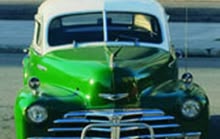Transport in Havana
Overview Transportation in Havana
- Try out the local bus or camiones privados
- Travel by train not recommended
- Rental car is easiest and most convenient option
- Keep speed limit in mind!
Getting to Havana
By plane
Visitors coming to Cuba will most likely get to the island by air. Scheduled flights arrive in Cuba from places all over the world. US travelers usually enter Cuba through Nassau, Toronto or Cancun instead of flying directly from the US, as such direct flights require previous permission of the US Treasury Department. Travel for US citizens to Cuba is restricted by the Department to a very restricted group of people, such as researchers and journalists. The national Cuban airline is Cubana de Aviación S.A., which services not only domestic air travel but also several international routes.
By ship
If not by air, another way of getting to Cuba is by sea, but given the US blockade, not many cruise ships head in Cuba’s direction. Privately owned boats and yachts, however, do call into Cuba’s many harbors and ports quite frequently.
Moving around Havana
By air: The national airline, Cubana, Lhasa very extensive network locally, that will get you to all of the island’s regional centers. These domestic flights are not too expensive. Charter flights are also a possibility – keep in mind that usually small propeller aircraft are used for these flights.
By bus: The company in Cuba providing the bus service is called Busse Viázul. The vehicles they use are very comfortable and feature air-conditioning. Fares are in dollars for all passengers. Camiones privados: meaning privately owned trucks in Spanish, they are very common means of transport for passengers, particularly in the eastern part of the island.
By train: Over the years, the train system in Cuba has notably slumped and deteriorated, making it the least favorable option of getting around Cuba. However, there are a few routes that have remained inexpensive and fairly well maintained between some of the most important cities, so it may be a good idea to enquire just in case.
Cuba has a very extensive road system so another very good option for getting around not only Havana, but Cuba as a whole, is renting a car. Many Cubans get around by hitchhiking and all government vehicles are required by law to pick up hitchhikers if they have room. Although renting a car is not one of the cheapest ways of getting around, it certainly gives you the freedom and comfort to thoroughly enjoy getting to know the island.
Useful Information
Petrol: There is a highly developed network of petrol stations on over 12,500 miles of tarred roads. Even so, it is always wise to have a full tank before starting a car journey and to re-fuel in good time.
Traffic: The traffic in Cuba, except for in the big cities, is light. You should watch out for people on bicycles on all roads. You should drive carefully at night: wild animals and poor lighting can be hazardous.
Follow the speed limit regulations: bear in mind that some of the roads may not be in top condition, in particular the roads outside the main traffic centers. It is better to drive a shorter distance and spend more time visiting many of the interesting sights on the way to your final destination.
Our Spanish Language School in Havana is ideally situated and students will have no problems at all in getting around town.

